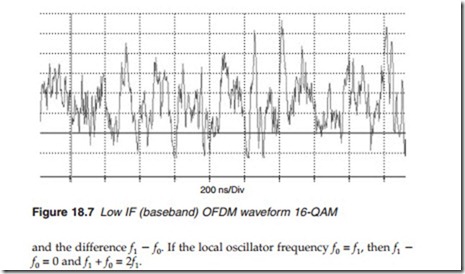DVB terrestrial channel decoder
The main components of a DTTV front end or channel decoder are shown in Figure 18.6. The tuner receives UHF-modulated signals from the terrestrial aerial, selects the appropriate channel and produces a modulated VHF IF. Before the IF can be processed, it is fed into a down-converter to produce what is known as a low IF. The down-converter removes the UHF carrier and retains the baseband signal with a centre frequency of 4.75 MHz or thereabouts, depending on the chipset used. The low IF is digitised by an ADC using a sampling frequency derived from the OFDM demodulator. The OFDM demodulator retrieves the original modulating transport stream and sends it to the FEC decoder.
The down-converter consists of a mixer followed by a lowpass filter. The function of a mixer is to change the frequency of an input signal. This is carried out by ‘mixing’ the original signal (frequency f1) and a separate signal (frequency f0) obtained from a local oscillator. The two signals are multiplied by the mixer to produce two beat frequencies: the sum f1 + f0
and the difference f1 – f0. If the local oscillator frequency f0
And here where the lowpass filter comes in. If the cut-off frequency of the lowpass filter is arranged to remove 2f1 and all frequencies above 2f1, the output will contain the modulating frequency fm only. Each one of the OFDM carrier frequencies would thus produce one modulating side frequency, fm1, fm2, fm3 and so on. The summation of all these fre- quencies is the baseband having the distinctive wave shape as illus- trated in Figure 18.7.

